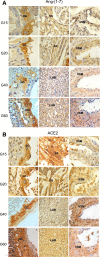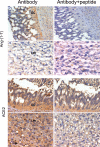Utero-placental expression of angiotensin-(1-7) and ACE2 in the pregnant guinea-pig
- PMID: 23339712
- PMCID: PMC3567991
- DOI: 10.1186/1477-7827-11-5
Utero-placental expression of angiotensin-(1-7) and ACE2 in the pregnant guinea-pig
Abstract
Background: In humans, trophoblast invasion, vascular remodeling and placental development are critical to determine the fate of pregnancy. Since guinea-pigs (GP) and humans share common pregnancy features including extensive trophoblast invasion, transformation of the uterine spiral arteries and a haemomonochorial placenta, the GP animal model was deemed suitable to extend our knowledge on the spatio-temporal immunoreactive expression of the vasodilator arpeptide of the renin-angiotensin system, angiotensin-(1-7) [Ang-(1-7)] and its main generating enzyme, angiotensin converting enzyme 2 (ACE2).
Methods: Utero-placental units were collected in days 15, 20, 40 and 60 of a 64-67 day long pregnancy in 25 Pirbright GP. Ang-(1-7) and ACE2 expression in utero-placental units were evaluated by immunohistochemistry.
Results: Ang-(1-7) and ACE2 were detected in the endothelium and syncytiotrophoblast of the labyrinthine placenta, interlobium, subplacenta, giant cells, syncytial sprouts, syncytial streamers, and myometrium throughout pregnancy. In late pregnancy, perivascular or intramural trophoblasts in spiral and mesometrial arteries expressed both factors. Immunoreactive Ang-(1-7) and ACE2 were present in decidua and in the vascular smooth muscle of spiral, myometrial and mesometrial arteries, which also express kallikrein (Kal), the bradykinin receptor 2 (B2R), vascular endothelial growth factor (VEGF) and its type 2 receptor (KDR), but no endothelial nitric oxide synthase (eNOS). In addition, the signal of Ang-(1-7) and ACE2 was especially remarkable in giant cells, which also show Kal, B2R. eNOS, VEGF and KDR.
Conclusions: The spatio-temporal expression of Ang-(1-7) and ACE2 in GP, similar to that of humans, supports a relevant evolutionary conserved function of Ang-(1-7) and ACE2 in decidualization, trophoblast invasion, vascular remodeling and placental flow regulation, as well as the validity of the GP model to understand the local adaptations of pregnancy. It also integrates Ang-(1-7) to the utero-placental vasodilatory network. However, its antiangiogenic effect may counterbalance the proangiogenic activity of some of the other vasodilator components.
Figures




Similar articles
-
Angiogenic, hyperpermeability and vasodilator network in utero-placental units along pregnancy in the guinea-pig (Cavia porcellus).Reprod Biol Endocrinol. 2008 Mar 27;6:13. doi: 10.1186/1477-7827-6-13. Reprod Biol Endocrinol. 2008. PMID: 18371207 Free PMC article.
-
Spatio-temporal expression of MMP-2, MMP-9 and tissue kallikrein in uteroplacental units of the pregnant guinea-pig (Cavia porcellus).Reprod Biol Endocrinol. 2007 Jul 2;5:27. doi: 10.1186/1477-7827-5-27. Reprod Biol Endocrinol. 2007. PMID: 17605824 Free PMC article.
-
Distribution of angiotensin-(1-7) and ACE2 in human placentas of normal and pathological pregnancies.Placenta. 2006 Feb-Mar;27(2-3):200-7. doi: 10.1016/j.placenta.2005.02.015. Epub 2005 Apr 25. Placenta. 2006. PMID: 16338465
-
Review: The angiogenic and vasodilatory utero-placental network.Placenta. 2011 Mar;32 Suppl 2:S170-5. doi: 10.1016/j.placenta.2011.01.008. Epub 2011 Feb 4. Placenta. 2011. PMID: 21295852 Review.
-
ACE2 of the heart: From angiotensin I to angiotensin (1-7).Cardiovasc Res. 2007 Feb 1;73(3):463-9. doi: 10.1016/j.cardiores.2006.09.006. Epub 2006 Sep 19. Cardiovasc Res. 2007. PMID: 17049503 Review.
Cited by
-
Maternal and neonatal response to COVID-19.Am J Physiol Endocrinol Metab. 2020 Aug 1;319(2):E315-E319. doi: 10.1152/ajpendo.00287.2020. Epub 2020 Jun 23. Am J Physiol Endocrinol Metab. 2020. PMID: 32574110 Free PMC article. Review.
-
Increased placental expression of angiotensin-converting enzyme 2, the receptor of SARS-CoV-2, associated with hypoxia in twin anemia-polycythemia sequence (TAPS).Placenta. 2021 Feb;105:7-13. doi: 10.1016/j.placenta.2021.01.008. Epub 2021 Jan 15. Placenta. 2021. PMID: 33497931 Free PMC article.
-
Role of ACE2 in pregnancy and potential implications for COVID-19 susceptibility.Clin Sci (Lond). 2021 Aug 13;135(15):1805-1824. doi: 10.1042/CS20210284. Clin Sci (Lond). 2021. PMID: 34338772 Free PMC article. Review.
-
SARS-CoV-2 Dissemination Through Peripheral Nerves Explains Multiple Organ Injury.Front Cell Neurosci. 2020 Aug 5;14:229. doi: 10.3389/fncel.2020.00229. eCollection 2020. Front Cell Neurosci. 2020. PMID: 32848621 Free PMC article.
-
The rat placental renin-angiotensin system - a gestational gene expression study.Reprod Biol Endocrinol. 2015 Aug 12;13:89. doi: 10.1186/s12958-015-0088-y. Reprod Biol Endocrinol. 2015. PMID: 26260700 Free PMC article.
References
Publication types
MeSH terms
Substances
Grants and funding
LinkOut - more resources
Full Text Sources
Other Literature Sources
Miscellaneous

